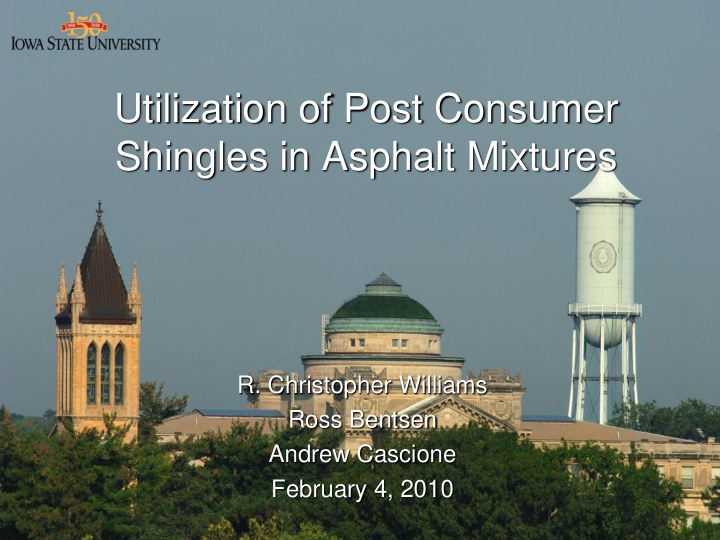



Utilization of Post Consumer Shingles in Asphalt Mixtures R. Christopher Williams Ross Bentsen Andrew Cascione February 4, 2010
Presentation Outline Introduction Federal requirements Source material properties Mix design & properties Ongoing Research – National Pooled Fund Study – Illinois Tollway Concluding thoughts
Introduction Asphalt shingles – Manufacturing scrap – Post consumer 60% of shingle sales are due to storm damage Asphalt shingles have multiple beneficial components for use in asphalt mixtures – Asphalt, Aggregate, Fibers, & Limestone filler
23 CFR Section 637B Quality Assurance Procedures for Construction 637.201 Purpose. To prescribe policies, procedures, and guidelines to assure the quality of materials and construction in all Federal-aid highway projects on the National Highway System 637.203 Definitions. 637.205 Policy. 637.207 Quality assurance program. 637.209 Laboratory and sampling and testing personnel qualifications.
Product Quality Characteristics Source material- recycled shingles – Limit loads of post-consumer shingles to residential buildings with four or fewer dwelling units (these buildings are not “regulated facilities” according to state and federal NESHAP 40 CFR Part 61, Subpart M ) . – Asbestos free – Deleterious material – Grind size – Moisture content
Product Quality Characteristics Asphalt mixture (hot mix or warm mix) – Limiting recycled asphalt binder content – Binder content – Voids criteria (lab air voids, field air voids, VMA , etc) – Smoothness
Sorting is manual
Challenge- Many new technologies in the asphalt industry Recycled shingles High RAP mixes Fractionated RAP Warm Mix Asphalt – Foaming Technologies – Organic Additives – Chemical Additives Bio Asphalt (non-petroleum)
Comparison of Field vs. Lab 1.0.E+08 1.0.E+07 RAP+RAS RAP+RAS+WMA RAP+WMA |E*|, kPa RAP 1.0.E+06 1.0.E+05 1.0.E+04 1.E-05 1.E-03 1.E-01 1.E+01 1.E+03 1.E+05 1.E+07 Frequency, Hz
What are our expectations? Performance expectations are met Materials and production/construction processes are economical Integration of sustainability – Recycling – Reduction of emissions – Carbon credits
Mix Design Approaches for Integration of RAS into HMA
Development of Mixture Design Process is no different than current methods of asphalt mix design development. Need to pay attention to integration of RAS into batching materials – Proportioned materials should be pre-blended prior to placement into oven. – Ensures even distribution of RAS throughout aggregate structure.
Outcomes of Mix Design Virgin binder content will be lower when RAS is utilized. 60-80% of RAS binder will be integrated into HMA mix. Voids in the Mineral Aggregate will increase with RAS utilization. Contribution of RAS binder to overall binder grade will not be known……… but!
Challenges AASHTO M323 binder recommendations assume complete mixing of new and recycled binder AASHTO M323 does not address RAS binders RAS rheology is different than paving binders
RAS Contribution to Performance Grade Recovered binder properties Estimated binder properties through mix testing – Dynamic modulus testing – Very sensitive to binder properties – Estimate effective performance grade – Hirsch and Witzcak Models – Mix Modulus = f(Binder modulus, VMA, & VFA)
Simple Performance Test
Graphical Representation
High Temperature
Low Temperature
HMA Production Considerations
Production Facilities Storage of RAS is for a limited time – 2-3 weeks – Can blend with a sand to extend storage time Counter Flow Drum is preferred 2 nd Recycle Chute is preferred upstream of RAP How is liquid asphalt paid for? – Separate- need to be able to track added RAS
Ongoing Research Work National Pooled Fund Study Illinois Tollway Region 5 EPA Headquarters EPA
Project Schedule
2009 Tollway RAS Research Recycled asphalt shingles (tear-offs) into high FRAP mixes Shoulder Binder and Bases – 5% RAS with 3 levels of FRAP (25%, 35%, 45%) Shoulder Surface – 5% RAS with 20% FRAP SMA Surface (SBS PG 76-22) – 5% RAS with 15% Fine FRAP
2009 Tollway RAS Research
2009 Tollway RAS Research 3.5 mile length of Outside Shoulder: I-90 Placement July-August 2009 8 Test Sections 4 Different RAS Shoulder Binder Mixes – 850 to 1300 tons each Standard (25% FRAP) and RAS Shoulder Surface placed over each – 1300 tons RAS Shoulder Surface
Tollway RAS Test Sections
Lab Tests Lab & Field Produced Mixes Dynamic modulus Beam fatigue Disc Compact Tension Recovered Binders
Laboratory Mixes
Field Mixes
Lab vs. Field
Summary The RAS binder contribution to the “mix” performance grade of combined binder can be reasonably estimated Warm mix asphalt technology is employing the same approach Warm mix asphalt & shingles are synergistic The approach is consistent with future mix performance testing
Concluding thoughts/questions Integrating shingles into asphalt mixture specifications is challenging. – New technologies – Composition of shingles is changing Are post consumer shingles a solid waste today, in 5 years, or 10 years? Two demonstration projects have been placed in Indiana- lab testing of materials will begin soon.
Acknowledgements Steven Gillen, Illinois Tollway Jay Behnke, STATE Testing Ray Bonaquist, AAT Chris Robinette, Granite Construction Jason Bausano, Navy Tamer Breakah, Iowa State University Andrea Kvasnak, NCAT
Thank You! & Questions?
Recommend
More recommend